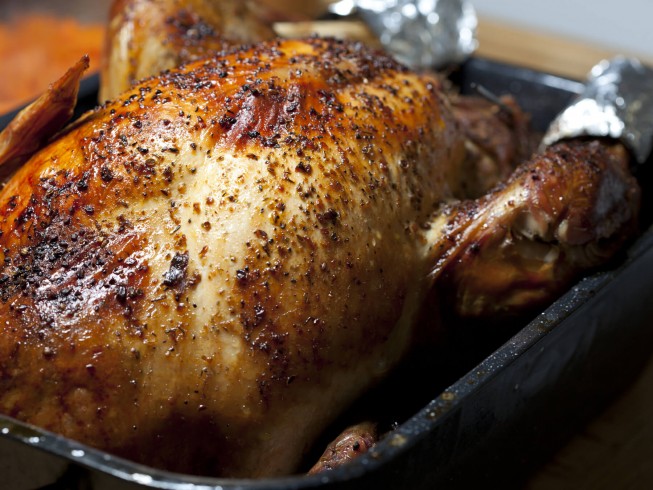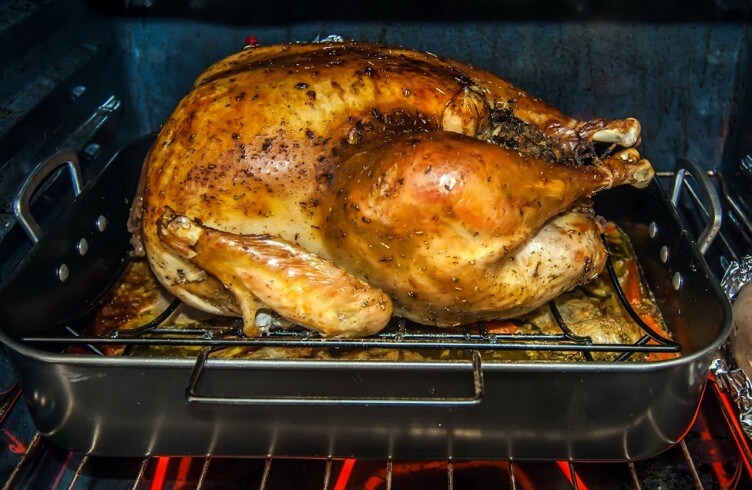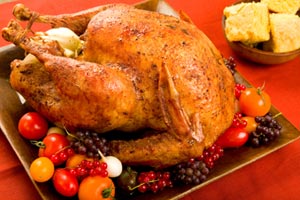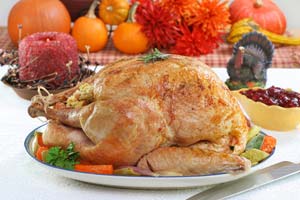Ranking #1 in nearly every "favorite cookie" poll, the chocolate chip cookie is pretty much the go-to cookie of choice for both kids and grownups alike.


What's the hurry? Slow-roasting is the way to go for an ultra-juicy bird, and a quick crank of the oven up to 500 gives this turkey a nice outer crust before the rest gets cooked.


14 pounds turkey, thawed if frozen, giblets and neck removed
butter, softened
salt
dried thyme
dried basil
black pepper
cayenne pepper
white pepper
Preheat the oven to 500 degrees F.
Rub the turkey on all sides with the butter. Wrap the tips of the wings and ends of the drumsticks in foil to prevent burning.
Season the outside and inside of the turkey with salt, thyme, basil, black pepper, cayenne pepper, and white pepper.
Place the turkey in a roasting pan and place in the oven. Roast at 500 degrees for 10-20 minutes or until it is lightly browned.
Lower the heat to 200 degrees F. Cook the turkey for 40-50 minutes per pound (9-11 hours for a 14 pound turkey) or until the turkey registers 160 degrees F in the thickest part of the breast. Baste the turkey occasionally (about once every 1 1/2 hours) with any accumulated juices in the roasting pan.
Remove the slow roasted turkey from the oven and let rest for 30 minutes before carving.
Do NOT stuff this turkey, due to the low cooking temperature it is unsafe to cook this turkey if stuffed. Cook the dressing separate.
To keep the turkey moist, place a pan of water on the lower rack of the oven to add humidity to the oven environment during roasting.
Rotate the roasting pan halfway through the cooking process for even browning and cooking, especially if your oven has hot spots.
For an extra juicy turkey, consider brining the turkey for 24 hours before roasting. This helps to season the bird thoroughly and retain moisture.
Make sure the turkey is fully thawed before roasting for even cooking. A partially frozen turkey will cook unevenly.
Season the inside cavity of the turkey well for more flavor throughout the meat.
For added flavor, consider placing aromatics like onion, garlic, and citrus inside the turkey cavity.
Basting can be done with butter or broth for extra moisture and flavor.
Use a reliable meat thermometer to check the turkey's internal temperature to avoid overcooking. Do not rely on a pop-up timer if one is included with your turkey.
Allow for enough time to slow roast the turkey based on its weight, planning your meal preparation accordingly.
Remember to save the pan drippings to make a flavorful gravy to accompany your slow-roasted turkey.
Starting at a high temperature of 500 degrees F quickly browns the skin of the turkey, giving it a nice, crispy exterior and sealing in the flavors before the temperature is lowered to slow-roast the inside to juicy perfection.
Basting the turkey occasionally with its own juices helps keep it moist during the long cooking process. Also, starting with a high oven temperature to quickly brown the skin helps lock in juices.
The turkey should reach an internal temperature of 160 degrees F in the thickest part of the breast. After resting, the temperature will continue to rise to the safe minimum of 165 degrees F.
Letting the turkey rest before carving allows the juices to redistribute throughout the meat, making sure the turkey remains moist and flavorful when served.
If the skin starts to brown too quickly, loosely cover the turkey with aluminum foil to prevent it from burning while it continues to slow-roast.
It is not safe to cook stuffing inside the turkey at such a low temperature due to the risk of bacterial growth. Cook the stuffing separately for safety purposes.
Injecting the turkey with a marinade or rubbing a mixture of butter and herbs under the skin can add more flavor to the meat.
The giblets and neck can be used to make homemade stock or gravy but should be removed from the turkey before cooking.
You can substitute with other herbs like rosemary, oregano, or sage. Fresh herbs can also be used; just adjust the amounts since fresh herbs have a different flavor intensity than dried ones (you'll want to use more fresh herbs than you would dried).
A heavy-duty roasting pan with low sides is best, as it allows air to circulate around the turkey. Avoid using disposable pans, as they may not be strong enough to hold the weight of the turkey.
Using an oven bag can help retain moisture and simplify clean-up, but be cautious as it will affect the browning of the skin. Follow oven bag instructions for proper usage.
Start by removing the legs and thighs, then slice the breast meat off, beginning at the top and working down horizontally. Let the turkey rest before carving to make this step easier.
Cool leftover turkey quickly by slicing it into smaller pieces. Store in an airtight container in the refrigerator for up to 3-4 days, or freeze for up to 2-3 months.
Yes, turkey leftovers can be reheated in the oven at a low temperature to retain moisture, or in the microwave. Add a little broth or water to keep the meat from drying out.
Roasting Pan: For holding the turkey while it roasts in the oven. It should be sturdy enough to support the weight of the turkey and deep enough to catch the drippings. Disposable pans are not recommended as they typically aren't strong enough to hold a large turkey.
Basting Brush or Spoon: For basting the turkey with its own juices periodically during the slow roasting process to keep the meat moist.
Aluminum Foil: Required to wrap the tips of the wings and ends of the drumsticks to prevent them from burning during roasting.
Meat Thermometer: Important for monitoring the internal temperature of the turkey, making sure it reaches 160 degrees F in the thickest part of the breast.
Carving Knife and Board: For slicing the turkey after it has rested.
Perfect Giblet Gravy: This rich and flavorful giblet gravy pairs well with the slow-roasted turkey. Made from the turkey's own giblets and drippings, it brings a depth of flavor that ties together the dish beautifully.
Cranberry Sauce: The tartness of this red wine cranberry sauce cuts through the richness of the turkey, providing a refreshing contrast that balances the meal beautifully.
Stuffing/Dressing: A flavorful dressing (cooked separately) complements the turkey perfectly.
Mashed Potatoes: Creamy, buttery mashed potatoes are a classic side that pairs warmly with turkey. They can soak up that delicious gravy, creating a comforting dish that everyone will love. These make-ahead mashed potatoes are a time saver, especially during the holidays.
Turkey Sandwiches: Utilize leftover turkey to make delicious turkey sandwiches. The juicy turkey pairs well with other leftovers for an easy lunch after the feast.
Turkey Pot Pie: Transform leftovers into an easy turkey pot pie, layered in a flaky crust.
Pumpkin Soup: A warm bowl of pumpkin soup would offer a lovely seasonal starter. The creaminess and slight sweetness of the soup contrast nicely with the savory turkey, creating a harmonious beginning.
Pecan Pie: Looking for dessert? A slice of pecan pie provides just the right sweetness to end the meal, with its rich, nutty flavor.
Ranking #1 in nearly every "favorite cookie" poll, the chocolate chip cookie is pretty much the go-to cookie of choice for both kids and grownups alike.
The name, vodka, comes from the Russian phrase zhiznennaia voda, or "water of life". It can be made from everything from potatoes to beets. It's considered to be fairly flavorless which makes it a great liquor for mixed drinks.
Love the spinach dip at restaurants like TGIFriday's and the Olive Garden? Make it at home with these easy-to-follow copycat recipes.


Online since 1995, CDKitchen has grown into a large collection of delicious recipes created by home cooks and professional chefs from around the world. We are all about tasty treats, good eats, and fun food. Join our community of 200K+ members - browse for a recipe, submit your own, add a review, or upload a recipe photo.

reviews & comments
December 23, 2020
Folks, there is no need to do anything other than follow this exactly as posted. No need to turn the bird three times because the temperature is so low. Just do as posted. At 200°F NOTHING is going to get overdone. Get a dual channel thermometer. One for in the thigh and one for in the oven. The breast will be 10 degrees higher when done. Pull the bird when the thigh registers 170°F. At this low temperature, every time you open the oven door, just add 20 more unnecessary minutes to the roast time. No need to overthink this. Health risk. Umm, let me see, salmonella dies at 150? If the bird is cooked to 170 through and into it's thickest part, where's the salmonella? Remember that the FDA has approved over 200 chemicals considered safe for Americans but banned in the EU beginning with Roundup. Just do what the post says.
November 28, 2020
I can't stress enough to those of you out there to buy a QUALITY dual channel, digital thermometer with an Air Probe with a Grate Clip and at least one leave-in probe. Ovens can vary in temperatures by as much as +/- 50 degrees F, commercial units included. When something baked this low, it's imperative to use a digital thermometer. Do not trust the dial or digital readout. Many of the newer models have a calibration procedure - using the thermometer placed in the center of the oven and check it. I would not recommend those cheap hanging ones either. I prefer ThermoWorks units but no knock-offs. ThermoWorks units are certified to be calibrated with great customer support. No, I don't work for them - this is cook to cook talk. I've used this method for a couple years now and the results are second to none.
Ok Folks, I have read and re-read the reviews/remarks and I believe I'm going with majority ith NicNac's recipe. But with a few changes as follow. Were getting a fresh 20lb bird that Will be brined. I will follow the above Ingredients list and put bird in right side up for twenty minutes at 500. Then turn bird upside and turn oven to 200 and cook six and half hours. Next turn the bird right side up and additional three and half hours , then last back to 500 for thirty minutes. Take out of oven and tent with foil. Then let wife have oven for a hour and then serve. Wish us luck !! If anyone reads this and see where I might be doing something wrong please advise. Don't want to mess this up !!:)
It says on every recipe to cook at 200 for slow roasting, why do people cook at 250 then say their turkey cooked to fast, well duh? Then the ones that stuff the turkey when recipe clearly states not to, low temp (200) does not work with slow roasting with stuffing. Follow directions people If you want correct results!!! Thatâs all
November 20, 2016
I have used this recipe for the last four years and never had an issue. I'm thinking the only issue is people are not calculating the correct amount of time for their turkey. A 22 pound bird times 50 minutes per pound is not 18 hours. So I don't know how you're doing your math, but it's actually 11 hours. So you're starting your bird way too early. I normally cook a 16 to 20 pound bird and I don't start it until 2am or 3am and it's ready by 2pm or 3pm in the afternoon and comes out perfect
November 28, 2013
I had a 20lb turkey and did ask directed...500 deg for 20 min..turned it down to 250 deg. 40 min per pound should have been approx. 13 hours. Started the 250deg. at 11pm...got up at 5:30am and my turkey was done/over cooked. The breast registered 194deg.! So much for these directions!
If your 20 pound turkey was overcooked after 6 hours at the lower temp, something is definitely wrong. A 20 pound turkey should take 6 hours to cook at 325 degrees. I would use an oven thermometer to check your oven at 200F and see if perhaps it's not accurate at that temp.
October 21, 2013
This is one of the best ways to cook a turkey because it gets the skin sort of seared to hold the juices in but it doesn't heat the tender turkey meat too quickly so it doesn't dry out. ALWAYS use a good meat thermometer to test for doneness.
November 22, 2012
I've slow roasted several turkeys ranging from 18lbs to 24lbs. 10 to 12 minutes is the time I cook the Turkey to get a golden color then turn oven to 200 degrees and cook for 45 min per lb and baste every hour to hour and a half and cover when two thirds done. Thigh temp when done I look for 175 degrees. Always comes out juicy and melt in your mouth tender
I'd like to slow roast a 17lb turkey and not risk overcooking. Can anyone give me directions and time guideline to roast at 200º?
You should be able to use a 17 pound turkey in this recipe, just account for the additional cooking time per pound
November 25, 2011
If you do this properly the temp should be at least 165*. Myself I cook the bird to 155* remove from oven cover well with heavy foil. after letting it rest for 1 hour I will reheat it at 400* for another 20 min. Let rest for fifteen,this should put your temp at 165 or a bit more,nice and juicy!
Thank you. I hve been looking for time per pound. Found lots of slow cook recipes but could find nothing about how long for a 17 pound turkey. I'll try 45 per pount. I have also heard turkey should be at 185 not 165
Bob, after browning 20 minutes @ 500F, you turn down the oven dial to 200F and YOU KEEP THE DOOR CLOSED! The oven will slowly lose heat while cooking the bird, raising the internal temp to a safe level before all the juices have a chance to cook out.
Bob, The best slow roast recipe I have found, and I have cooked 100's of turkeys since being a chef, is to (brine the bird is desired) cook a 25 lb bird at 200d for 12-13 hrs upsidedown 2/3 the time. last 1/3 flip the bird rightside up and 30 mins before finishing broil to crisp the skin. Super simple, sounds worse then it is. Use a thermometer to temp the bird, 165d internal. Hope it helps.
This method appeals to me even though slow roasting is not recommended due to health risk question...after browning 20 mins@500F....do you turn the oven dial to 200F while not opening the door, or do you open the door , wait till it goes down to 200F and then continue??? Thanks Bob
After the 20 minutes at 500 degrees F, simply turn the temperature down to 200 degrees F. No need to open the door or do anything. Just leave the turkey in the oven while the temperature lowers.